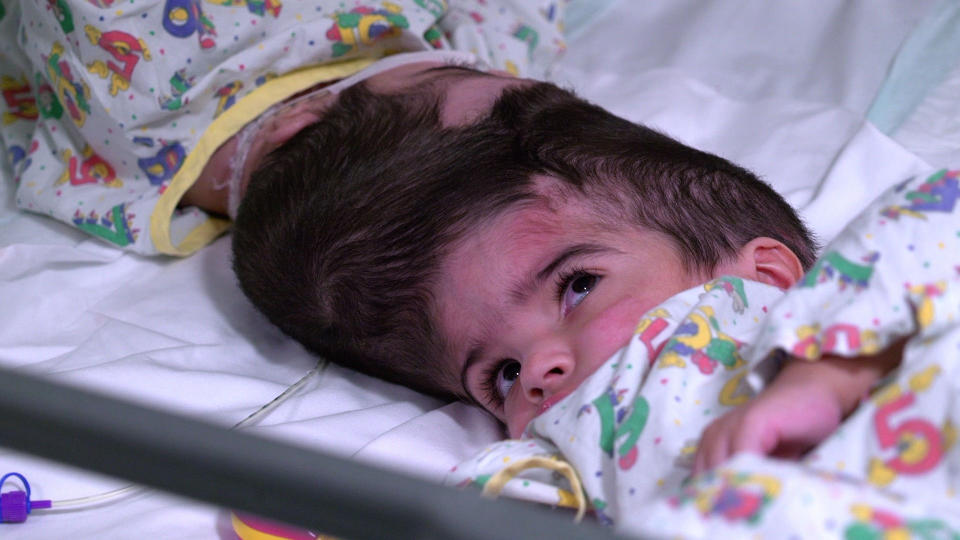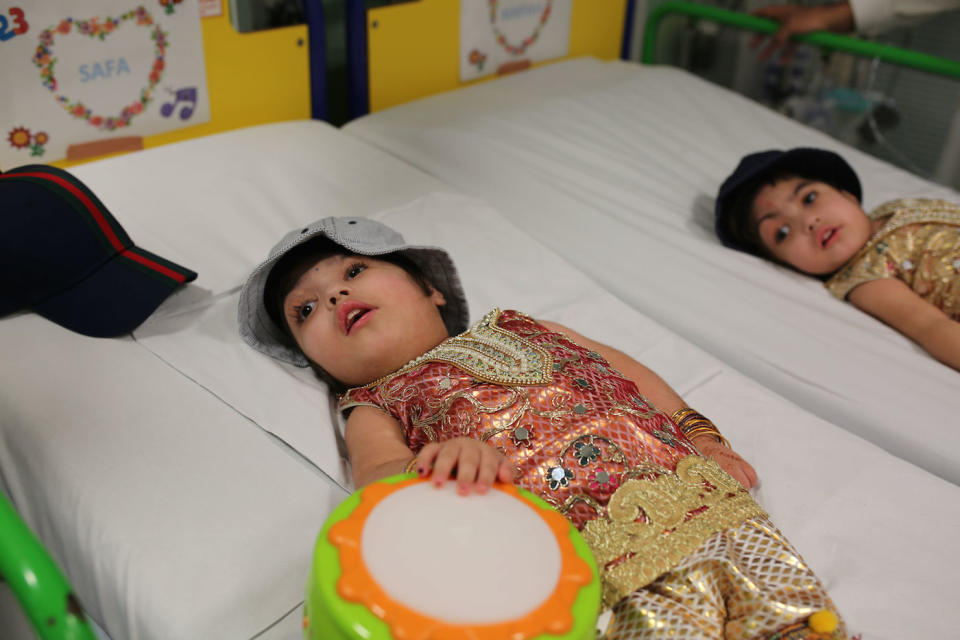How did surgeons perform 55 hours of surgery to separate 'miracle' conjoined twins?

Rare conjoined twins have been separated at a world-leading hospital in London, surgeons have announced.
Two-year-old sisters Safa and Marwa Ullah, from Charsadda in Pakistan, underwent three major operations to separate their heads at Great Ormond Street (GOSH).
It took a total of 55 hours of surgery to separate the twin sisters, the first operation taking place last October when they were 19 months old.
The final operation, which saw them separated, was carried out on February 11 this year.
The BBC followed the story of Safa and Marwa through a series of operations over that five-month period.

Surgeons first had to study the girls’ brains and then spent months preparing for the complex surgery.
They then had to remove three large segments of skull, which they would later reattach between operations as a rigid frame held together by metal mesh and screws.
Next, the surgeons had to clamp and seal the arteries which carried blood from one twin to the other, before using a soft sheet of medical plastic to keep the once-joined brains separate and prevent them from reconnecting.
Tissue expanders – four empty plastic sacs placed underneath the skin which were then filled with saline – were used to stretch the skin before the girls were finally separated.
Their partially exposed heads were wrapped in plastic film before they could be safely moved to separate operating theatres for the final stages of the procedure.
Final reconstruction was done using the twins’ own bone, fragments of which were “jigsawed”, the BBC said, over their heads, and eventually covered with the expanded skin.
Great Ormond Street Hospital has previously successfully separated craniopagus twins – with their skulls and blood vessels fused together like Safa and Marwa – in 2006 and 2011.
The girls, who were born by Caesarean section, were craniopagus twins, with their skulls and blood vessels fused together.

In order to ensure the operations went smoothly, experts used virtual reality to create an exact replica of the girls' anatomy.
This enabled surgeons to visualise the complex structure of their skulls as well as the positioning of their brains and blood vessels.
Read more
Giant jellyfish captured on camera swimming with diver off Cornwall coast
Man accused of killing pregnant mother and her baby appears in court
July school holidays traffic this weekend will be the ‘worst for five years’
A team also used 3D printing to create plastic models of the structures that could be used for practice. Cutting guides were created so that surgeons could work more precisely.
During the surgery, doctors first worked to separate the girls' blood vessels and then inserted a piece of plastic into their heads to keep the brains and blood vessels apart.
Scans had shown that the girls have two distinct brains but these are misshapen, which the plastic and an accompanying pulley system helped to correct.

During further surgery, the girls started to bleed after clots formed in Safa's neck veins and she began to shunt blood to her twin.
Doctors feared they would lose Marwa during the operation after her heart rate fell. As a result of her complications, they gave her a key vein that the twins shared.
But this had an impact on Safa, who suffered a stroke less than 12 hours later due to the loss of the vein.
The final major operation involved medics building new skulls using the girls' own bone. They also used tissue expanders to ensure the girls' own skin would stretch over the top of each of their heads.
The surgery, which was paid for by Pakistani businessman Murtaza Lakhani, has been followed by several smaller procedures to enable the girls to live independent lives.
The operations added up to 55 hours of surgery time and involved 100 members of staff from Great Ormond Street.
The girls' mother, Zainab Bibi, 34, who has previously had seven children, said: "We are indebted to the hospital and to the staff, and we would like to thank them for everything they have done.
"We are extremely excited about the future."

The girls, whose father died of a heart attack while their mother was pregnant with them, were discharged from GOSH on July 1 and moved to a London address with their mother, grandfather Mohammad Sadat Hussain, 57, and uncle, Mohammad Idrees.
The twins are now undergoing daily physiotherapy as part of their ongoing rehabilitation.
Neurosurgeon Noor ul Owase Jeelani and craniofacial surgeon Professor David Dunaway led the team that operated on the girls.
Mr Jeelani, a neurosurgeon at GOSH, and Professor Dunaway, head of the hospital's craniofacial unit, said in a statement: "We are delighted we have been able to help Safa and Marwa and their family.
"It has been a long and complex journey for them, and for the clinical team looking after them.
"From our personal point of view, it has been great to get to know the girls and their family.
"Their faith and determination have been so important in getting them through the challenges they have faced. We are incredibly proud of them.”
Cecelia Carney, team leader of GOSH's neurosurgery theatre, said: "The intricacies of the series of surgical procedures were planned meticulously as a team."
Conjoined twins are very rare - affecting only about one in every 2.5 million births.

 Yahoo News
Yahoo News 
